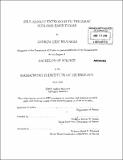| dc.contributor.advisor | Roman W. Jackiw. | en_US |
| dc.contributor.author | Brainerd, Andrew Eric | en_US |
| dc.contributor.other | Massachusetts Institute of Technology. Dept. of Physics. | en_US |
| dc.date.accessioned | 2011-02-23T14:29:00Z | |
| dc.date.available | 2011-02-23T14:29:00Z | |
| dc.date.copyright | 2010 | en_US |
| dc.date.issued | 2010 | en_US |
| dc.identifier.uri | http://hdl.handle.net/1721.1/61203 | |
| dc.description | Thesis (S.B.)--Massachusetts Institute of Technology, Dept. of Physics, 2010. | en_US |
| dc.description | Cataloged from PDF version of thesis. | en_US |
| dc.description | Includes bibliographical references (p. 43). | en_US |
| dc.description.abstract | The Dirac equation is the relativistic generalization of the Schrödinger equation for spin 1/2 particles. It is written in the form -ihc -ihac OXIa+t' Omc 29 = ih-o (1.1) where V) is a four component Dirac spinor and the coefficients a and # are 4 x 4 matrices. Like the Schrödinger equation, the Dirac equation can be written as a time-independent eigenvalue equation H# = E* for a Hamiltonian operator H and energy eigenvalue E through separation of variables. The energy eigenvalues obtained by solving this equation must be real- one of the axioms of quantum mechanics is that physical observables, in this case energy, correspond to self-adjoint operators, in this case the Hamiltonian operator HI, acting on the Hilbert space 7H which describes the system in question. It can easily be shown that self-adjoint operators must have real eigenvalues. The reality of the energy eigenvalues becomes important when examining hydrogenic atoms using the Dirac equation. These atoms can be described by a Coulomb potential, V(r) = -Ze 2 /r, where Z is the number of protons in the nucleus and e is the elementary charge. When the nonrelativistic Schrodinger equation is solved for a Coulomb potential, the energy levels are given by the familiar Rydberg formula Z 2a 2mc2 1 En 2 2 (1.2) where Z is the number of protons in the atomic nucleus, a is the fine structure constant, m is the electron mass, c is the speed of light, and n a positive integer. Note that this formula assumes a stationary positive charge of infinite mass at the center of the atom, and that the energy levels for a more realistic model of an atom with a nucleus of finite mass M are given by replacing m with the reduced mass = mM/(m + M) in Eq. (1.2). When the Dirac equation in a Coulomb potential is used instead of the nonrelativistic Schrödinger equation, the energy levels are instead given by - 1/2 En, = mc2 1+ a2 (1.3) n' - j j + )2_ - 2Z2 where n' is a positive integer and j is the total angular momentum of the electron. The total angular momentum j can take on values in the range 1/2, 3/2, ..., n' - 1/2. The eigenvalues in Eq. (1.3) match those in Eq. (1.2) in the limit VZ < 1, noting that in Eq. (1.2), a free electron is considered to have an energy of 0, while in Eq. (1.3), a free electron has energy mc2 . A problem arises with Eq. (1.3) when aZ > j--. The quantity (j + 2- aZ 2 is imaginary, causing Eq. (1.3) to yield complex energy eigenvalues. Since the eigenvalues of a self-adjoint operator must all be real, this indicates that the Hamiltonian cannot be self-adjoint when aZ > j + 1. This issue raises two questions. The first is whether there is a physical explanation for the failure of Eq. (1.2) for large Z. The second is whether this problem can be addressed mathematically by defining a new, self-adjoint operator H., which is constructed from the old Hamiltonian H as a self-adjoint extension. In this thesis, I will answer both of these questions in the affirmative, relying and building upon work done by others on these questions. I will show how the failure of Eq. (1.2) can be motivated by physical considerations, and I will examine a family of self-adjoint extensions to the Dirac Coulomb Hamiltonian constructed using von Neumann's method of deficiency indices. | en_US |
| dc.description.statementofresponsibility | by Andrew Eric Brainerd. | en_US |
| dc.format.extent | 43 p. | en_US |
| dc.language.iso | eng | en_US |
| dc.publisher | Massachusetts Institute of Technology | en_US |
| dc.rights | M.I.T. theses are protected by
copyright. They may be viewed from this source for any purpose, but
reproduction or distribution in any format is prohibited without written
permission. See provided URL for inquiries about permission. | en_US |
| dc.rights.uri | http://dspace.mit.edu/handle/1721.1/7582 | en_US |
| dc.subject | Physics. | en_US |
| dc.title | Self-adjoint extensions to the Dirac Coulomb Hamiltonian | en_US |
| dc.type | Thesis | en_US |
| dc.description.degree | S.B. | en_US |
| dc.contributor.department | Massachusetts Institute of Technology. Department of Physics | |
| dc.identifier.oclc | 701106459 | en_US |
